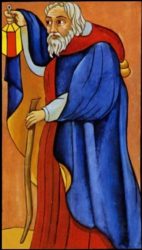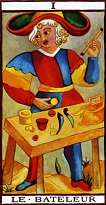The Aim of Meditation
In the Letter on the Fool, we learn that Christian meditation pursues the aim of deepening the two divine revelations:
Ultimately, this will awaken a consciousness and appreciation of Christ’s work of Redemption. Hence, our meditation will lead to contemplation of the seven stages of the Passion. That task will be a follow up to this essay.
Sacrifice
To understand the Redemption, it is first necessary to start with understanding the cosmic significance of the idea of Sacrifice. In the Letter on the Emperor, we learn of two sacrifices:
- Creation is a sacrifice: to allow freedom
- Incarnation is a sacrifice: the fact of freedom
Creation is effected by a divine contraction and by voluntary divine powerlessness, which is akin to crucifixion. Freedom is the key to understanding Providence in history. On the one hand, without freedom, God would be a “divine tyrant”; yet on the other hand, because of man’s freedom, God’s power may be falsely doubted. Tomberg summarizes it:
God is all-powerful in history inasmuch as there is faith; he is crucified insofar as one turns away from him.
The fact of freedom led to the Incarnation. The sacrifice is not limited to the cross, since the Incarnation itself was a sacrifice. Sergius Bulgakov in Sophia: The Wisdom of God describes it this way.
Christ underwent all the limitations and infirmities of human life. He was subject to every human propensity: he experienced hunger and thirst, exhaustion, grief, temptation. … The agony [of the cross] provides clear evidence at once of the reality of his human nature and of the depth of his self-abasement.
Moreover, his understanding of man’s nature was not sugar-coated as it so often is today. Christ was fully aware of the human race living in spiritual darkness with stupidity, weakness, sloth, lust, injustice, disease … in short, sin. This was accompanied by the awareness of God’s wrath. Bulgakov concludes:
in his human nature the representative human feels the force of the sin of the whole world pressing upon him, the horror, for the one sinless being, of contact with sin, and of the justice of God outraged thereby.
Stages of Meditation
Tomberg describes three stages of meditation, above our ordinary waking consciousness. These stages, in a sense, correspond to the four levels of interpretation of sacred writings. These are summarized in the following table:
| Stage |
Object |
Experience |
Interpretation |
| Objective Consciousness |
External images and sounds |
Sensory phenomena |
Literal |
| Imagination |
Concentration on an inner image |
Perception of spiritual phenomena |
Allegorical |
| Inspiration |
Inner silence, listening |
Spiritual communications |
Moral |
| Intuition |
Beyond words and thoughts |
Spiritual identification |
Anagogical |
In our ordinary state of objective consciousness, we learn the faith through sensory images and hearing. Exoteric faith is learned through images such as icons, statues, stained glass, art work, and the like. It is also taught by an authority.
Imagination
The beginning of meditation is our imagination (which Tomberg also calls “vision”) by which we try to concentrate on interior images. We try to visualize the events, perhaps even placing ourselves in them. Tomberg describes this as augmenting our experience. Objective consciousness is passive in respect to experiences, but the imagination is active. This may lead to the perception of spiritual phenomena, as described by several saints and venerables. Anne Catherine Emmerich and Maria d’Agreda have been such visionaries.
St. Francis de Sales describes this stage as the mind meditating on a subject with the aid of the imagination and discourse or reasoning.
Inspiration
In inspiration, we try to quiet the mind, listening silently. Whereas imagination requires effort, this stage is the beginning of concentration without effort. In silence, the gifts of understanding or wisdom may be received. Ideas or dogmas that seemed to be difficult to understand begin to make sense. Sometimes, issues in your own life will be cleared up. You may find that things “just happen” favourably. Not necessarily in your material life, but more so in your spiritual life, as one depends more and more on this for moral guidance.
Intuition
At the stage of ordinary consciousness, the source of knowledge or faith is from beyond one’s own being. Even at the stage of imagination, the images are still in a sense external, as something the I actively creates and envisions. There is still some of that in inspiration, although the process is passive rather than active; the source is beyond the I. In other words, there is the I, or Self, confronting an experience, whether sensory or spiritual.
In the stage of intuition, however, all images, words, and thoughts are relinquished. This may even feel like a “dark night”, a time of abandonment. The consolations of spiritual visions and communications seem to disappear. That is because the I itself must go. It is not a matter of a new and elevated experience, but rather a transformation of one’s very being.
Tomberg gives us the example of St Paul on the road to Damascus, to illustrate the three stages of vision, inspiration, and imagination:
- Vision: He had the vision of Christ
- Inspiration: He received communication
- Intuition: No longer I who live, but Christ who lives in me
Purgation of the Senses and the Spirit
Given the importance of St. John of the Cross in the Meditations, it is worthwhile to learn from him. On the path to the Unitive Way, two conversions are necessary based on the purgation of the senses and the purgation of the spirit. “Thou shalt love the Lord thy God with thy whole heart, and with thy whole soul, and with all thy strength, and with all thy mind.” (Luke 10:27) According to Fr. Garrigou-Lagrange in The Three Conversions of the Spiritual Life, this requires loving God for His own sake, not from self-interest or attachments. To love God with your whole mind means that your love is not affected by the ebb and flow of our experiences. This awareness will counteract the feeling of abandonment on the way to Union.
Hermetically, the path through the stages of mediations involves an alchemical transformation of the spirit, soul, and matter. This transformation is summed up by this pattern:
- From the state of primordial purity before the Fall
- To the state after the Fall
- To Reintegration
Hence, there are a series of meditations suggested by Tomberg, that start by meditating on the state of primordial purity, concluding ultimately on the meditation on the Passion. This is the proposed sequence of meditations:
- The seven days of creation
- The seven stages of the Fall
- The seven miracles of St. John’s Gospel
- The seven “I am” sayings of Christ
- The seven last words of Christ
- The seven stages of the passion
The third stage is reached following the understanding of the Passion and then the Resurrection. Fr. Garrigou-Lagrange summarizes the stages, based on the three conversions of the Apostles:
- First Conversion: They became disciples of the Master, attracted by the sublime beauty of His teaching.
- Second Conversion: This came at the end of the Passion, which had enabled them to divine the fecundity of the mystery of the Cross, enlightened by the Resurrection which followed it;
- Third Conversion: It filled them with the profound conviction of this mystery. This resulted in a complete transformation of their souls.
The events of the Passion that are fruitful for meditation are these:
- Washing of the feet
- The scourging
- Crown of thorns
- The way of the cross
- The crucifixion
- The entombment
- The resurrection
A more detailed examination of each of these will follow during the week.
Epilog on Love
The Scripture readings for Quinquagesima Sunday illustrate the first and third conversion. The Gospel was about the blind man by the side of the road (Luke 18:31-43) St. Gregory the Great understood this as an allegory about the human race, which was in a state of darkness following the Fall, but then came into the light.
The other text was from 1 Corinthians 13:1-13, the famous sermon on Love, or actually on Charity. Everyone seems today to know what love is, without realizing how difficult it is, what is worth loving, or even how to go about loving. Charity means “love” in the sense of the commandment to love God and your neighbor as yourself. As such, charity is the goal, not the beginning. The gifts of the Holy Spirit lead to Charity. It requires understanding and wisdom to know what to love. It takes strength to love in the face of adversity. Fr. Garrigou-Lagrange sums it up like this:
It is impossible to have a high degree of charity without having at the same time and in a proportionate degree the gifts of understanding and wisdom, gifts which, together with faith, are the principle of the infused contemplation of revealed mysteries.



